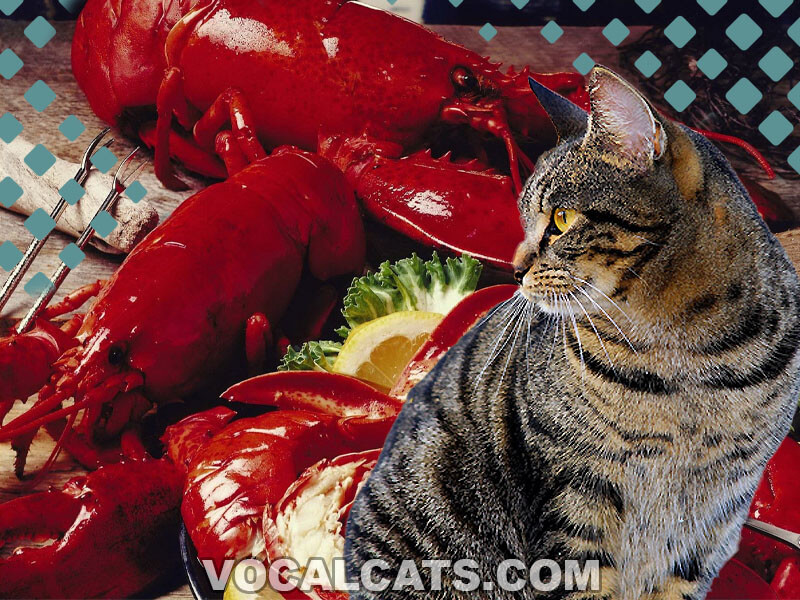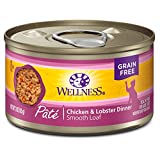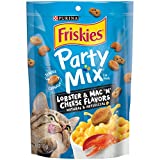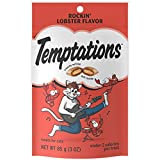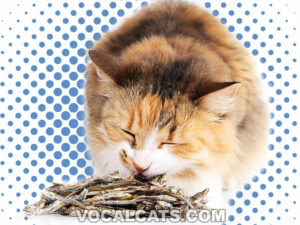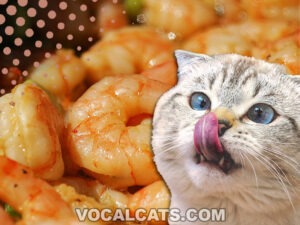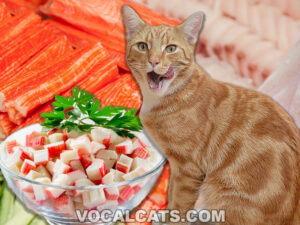Can Cats Eat Lobster? Yes, cats can eat Lobster in small amounts or in moderation, as it is a good source of protein and essential nutrients. However, it is crucial to remove the shells and cook the Lobster meat thoroughly before feeding it to your feline friends. Additionally, avoid adding any spices, seasonings, or butter, as these can be harmful to cats.
You’re enjoying your seafood boil dish filled with succulent Lobster and fresh clams. The mouth-watering blend of spices and flavors fills the room and captures your feline companion’s attention.
Your cat jumps onto the chair beside you, and their eyes are glistening with curiosity and desire. They tilt their head and paw gently at your arm, begging for a little of the enticing seafood feast.
You can’t help but chuckle at your cat’s persistence, wondering whether indulging them in a small taste of Lobster meat and other crustaceans seafood would be safe.
In this article, we’ll explore whether cats can have Lobster, touch upon its nutritional aspects, and consider how it may affect your cat’s health.
RECOMMENDED: Can Cats Eat Shrimp?
Contents
- Can Cats have Lobster?
- What is a Lobster?
- Is Lobster good for Cats?
- Is Lobster bad for cats?
- Is Lobster safe for Cats?
- Do Cats like Lobster?
- How much Lobster meat can you give your cat?
- How often can you give your cat Lobster meat?
- How to properly feed your Cat Lobster
- Cat and Lobster
- Lobster cat food
- Safe and feline-friendly alternative to Lobster for cats
- Lobster Cat Treats
- So, Can Cats Eat Lobster?
- Related Questions
Can Cats have Lobster?
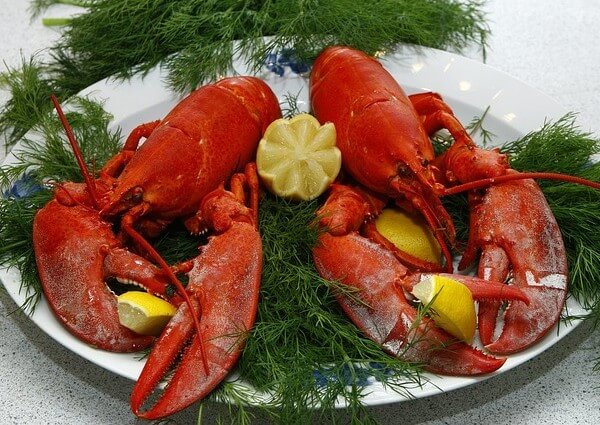
Yes, cats can have Lobster in small quantities and as an occasional treat. However, Lobster should not be a part of their regular daily diet because Lobster meat is not an ideal protein source for them.
As descendants of desert cats, seafood wasn’t part of their natural diet, so their digestive system isn’t naturally adapted to digesting seafood properly.
Additionally, it’s crucial to know the origin of your Lobster meat, as there are differences between wild-caught and farm-raised Lobsters.
On the one hand, wild-caught Lobsters typically have a more diverse diet, resulting in a higher content of omega-3 fatty acids, essential minerals, and vitamins.
On the other hand, farm-raised Lobsters are often fed a controlled diet and may be exposed to antibiotics or other chemicals used in aquaculture practices. This type of environment can impact their nutritional value and lead to lower nutrient content.
Due to these factors, treating Lobster as an occasional snack rather than a regular part of your cat’s daily diet is best.
RELATED: Can Cats Eat Crab?
What is a Lobster?
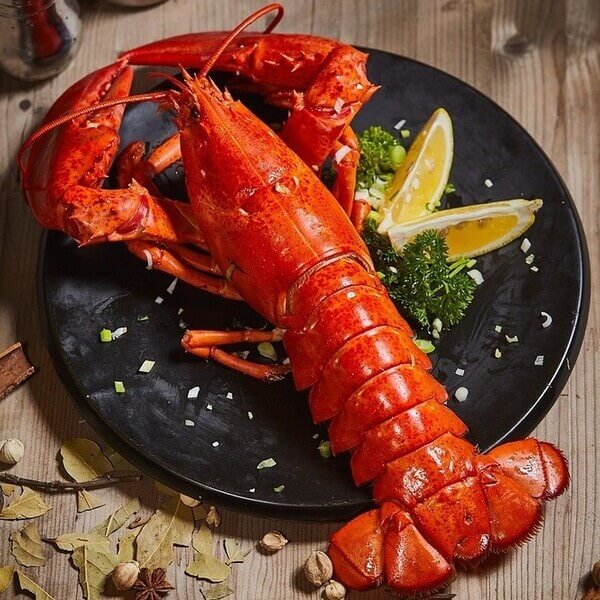
A Lobster is a marine crustacean known for its distinctive exoskeleton, giant claws, and elongated body.
Belonging to the family Nephropidae, Lobsters are found in various habitats, including sandy, rocky, and muddy ocean floors. They thrive in colder waters.
Lobsters are known to be omnivorous scavengers. They feed on a wide range of sea life, such as mollusks, small fish, and other crustaceans.
Lobsters are prized for their tender, flavorful meat and are considered a delicacy in many cultures worldwide.
To fully understand why our feline friends should consume Lobster in small amounts and as an occasional rare treat, let’s take a closer look at its nutritional content and see how it may benefit or harm your cat’s health.
READ ALSO: Can Cats Eat Anchovies? (Dried, Canned, Raw & Oil)
Lobster nutrition facts
Lobster meat nutrition facts (3oz (85 grams) of cooked, shell removed Lobster)
| Name, Unit | Amount |
| Water, g | 66.4 |
| Calories, cal | 75.6 |
| Protein, g | 16.2 |
| Total Fat, g | 0.731 |
| Calcium, mg | 81.6 |
| Iron, mg | 0.246 |
| Magnesium, mg | 36.6 |
| Phosphorus, mg | 157 |
| Potassium, mg | 196 |
| Sodium, mg | 413 |
| Zinc, mg | 3.44 |
| Copper, mg | 1.32 |
| Manganese, mg | 0.055 |
| Selenium, µg | 62.1 |
| Thiamin, mg | 0.02 |
| Riboflavin, mg | 0.014 |
| Niacin, mg | 1.56 |
| Pantothenic acid, mg | 1.42 |
| Vitamin B-6, mg | 0.101 |
| Folate, µg | 9.35 |
| Choline, mg | 68.8 |
| Vitamin B-12, µg | 1.22 |
| Vitamin A, µg | 0.85 |
| Vitamin E, mg | 0.85 |
| Vitamin D, IU | 0.85 |
Based on the nutrition table, we can see that in 3 ounces or 85 grams of cooked Lobster meat, there are 75.6 calories, 16.2 grams of protein, 0.731 grams of fat, and 413 milligrams of sodium.
It also provides calcium, magnesium, zinc, potassium, phosphorus, and folate minerals.
Moreover, 85 grams of cooked Lobster meat contains B vitamins and vitamins A, D, and E.
Next, we will go over how the minerals and vitamins in Lobster meat can positively impact your cat’s overall health.
Is Lobster good for Cats?
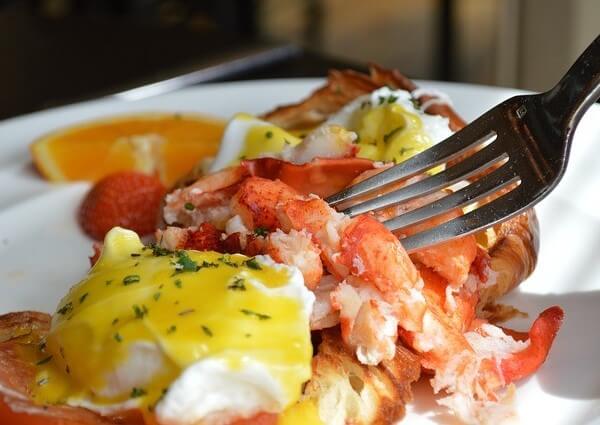
Yes, Lobster can be good for cats when served in small quantities and when prepared properly.
So how do you properly prepare Lobster for feline consumption?
Proper preparation of Lobster meat includes steaming or boiling the Lobster to preserve the most nutrients, and your four-legged friends should only consume Lobster meat.
Lobster can be a decent treat for cats when consumed in moderation because it contains various vitamins and minerals that can benefit your kitties’ health. These nutrients include:
Protein in Lobster provides muscle growth and repair in cats
Lobster is a good source of high-quality protein, which is essential for muscle growth and repair, as well as maintaining a healthy immune system in cats.
Omega-3 fatty acids in Lobster promote healthy brain functions in cats
Lobster meat also contains omega-3 fatty acids, which are essential for maintaining a healthy coat, heart, and brain function in cats.
There are three types of omega-3 fatty acids: alpha-linolenic acid (ALA), eicosapentaenoic acid (EPA), and docosahexaenoic acid (DHA).
The two types of omega-3 fatty acids you can find in Lobster meat are EPA and DHA. Both of them have anti-inflammatory properties, and they are known to help with the following:
- Support brain and cognitive function.
- Help reduce inflammation.
- Maintain a healthy coat and skin in cats.
Vitamin B6 and B12 in Lobster are essential nutrients our cats need
Vitamin B6 and B12 are essential nutrients that our furry friends need. These vitamins are crucial for a cat’s overall health and well-being.
If you’re wondering how, here’s how:
Vitamin B-6 (Pyridoxine)
This vitamin is crucial for a cat’s health as it helps with protein metabolism, red blood cell formation, and synthesizing neurotransmitters (chemical messengers in the brain).
Vitamin B-6 also supports a healthy immune system, and it is necessary for hormones, such as insulin and growth hormones, to function correctly.
Vitamin B-12 (Cobalamin)
Vitamin B-12 is essential for maintaining a healthy nervous system in cats. That’s because it synthesizes myelin, a fatty substance that insulates nerve cells and ensures efficient nerve signal transmission.
Additionally, vitamin B-12 supports red blood cell formation, DNA synthesis, and proper metabolism of amino acids and fatty acids. Cats with vitamin B-12 deficiency can experience anemia, neurological issues, and growth problems.
Zinc in Lobster supports a healthy immune system in cats
Zinc is a vital mineral for cats. It helps maintain a robust immune system, supports wound healing, and is crucial for proper growth and development in cats.
Calcium in Lobster fosters strong bones and muscles in cats
Calcium is vital for a cat’s bone health, dental health, and muscle function. It aids in blood clotting, nerve transmission, and maintaining a regular heartbeat.
Cats need appropriate calcium intake to avoid health issues like weak bones and dental problems.
Phosphorus in Lobster helps maintain strong teeth and bones in cats
Phosphorus works hand in hand with calcium in maintaining strong bones and teeth in cats.
This essential mineral is an important component of cell membranes and is involved in energy production.
All cats need phosphorus because it plays a crucial role in forming adenosine triphosphate (ATP), the primary energy molecule for cells.
Potassium in Lobster supports nerve functions in cats
Potassium is an essential mineral that helps maintain proper fluid balance and nerve and muscle function in cats. It is crucial for maintaining a regular heartbeat and can help prevent muscle weakness and cramping.
An adequate intake of potassium is vital for a cat’s overall health.
Magnesium in Lobster encourages energy production in cats
Magnesium is necessary for various biochemical reactions in a cat’s body, including energy production, protein synthesis, and muscle and nerve function.
It also plays a role in maintaining healthy bones and teeth.
A balanced magnesium intake helps support a cat’s overall well-being.
Lobsters contain amino acids that all cats need
Additionally, Lobster meat contains amino acids like arginine, lysine, and methionine. These are all essential for maintaining a cat’s muscle mass, supporting the immune system, and promoting healthy skin and fur.
Remember that while Lobsters contain the essential minerals listed above, this seafood should be consumed as a rare occasional treat and in moderation.
And although Lobster meat contains vitamins and minerals such as calcium, iron, magnesium, phosphorus, potassium, zinc, copper, and selenium, it doesn’t have all the nutrients your cat needs for optimal health.
Therefore, your fuzzy friends should receive these minerals from their regular daily cat food. All cat food should contain the minerals we’ve listed above. If you need to figure out the best cat food brand for your furry friends, we highly recommend speaking with your vet.
Lobsters do not contain carbohydrates
As we know, cats are obligate carnivores, meaning they need animal-based protein. Our furry friend’s digestive systems are also specifically designed to process and absorb nutrients from meat rather than carbohydrates.
Since Lobster meat does not contain carbohydrates, this seafood treat is an excellent option for felines.
A high-protein, low-carbohydrate diet is more in line with their evolutionary needs, helping them maintain optimal health, weight, and overall well-being.
When it comes to your cat’s diet, you want to avoid feeding him a diet that contains a lot of carbohydrates. Too many carbs can lead to weight gain, obesity, and other health issues.
Before we move on from this section, we want to note that cat parents should choose fresh, live Lobster, as it typically contains less mercury than other seafood varieties.
Now, let’s explore some potential downsides to feeding your cat Lobster.
Is Lobster bad for cats?
While Lobster can be a tasty treat for cats, it can pose some health risks.
Here are some reasons why Lobster can be bad for cats:
1. High in sodium, cholesterol, fat, and calories
Lobster meat is high in sodium. In just 3 ounces of Lobster meat, there is 413 mg of sodium. While this may not seem like a lot of sodium for us, it is definitely a lot of sodium for our little kitties.
That’s because adult cats generally need 200 milligrams of sodium per kilogram of body weight per day or between 21 and 42 milligrams of sodium per 100 calories of food.
If your cat consumes more sodium than he needs, he will experience symptoms of salt toxicity. Some of the signs and symptoms of sodium poisoning include the following:
- Vomiting
- Diarrhea
- Dehydration
- Excessive thirst (polydipsia)
- Increased urination (polyuria)
- Lethargy or weakness
- Loss of appetite
- Swelling or edema (particularly in the limbs)
- Incoordination or difficulty walking (ataxia)
- Muscle tremors
- High blood pressure
- Heart problems.
- Seizures (in severe cases)
- Elevated heart rate (tachycardia)
- Coma (in severe cases)
If you suspect your four-legged friend is suffering from sodium poisoning, please contact your veterinarian right away. Salt poisoning requires immediate medical attention. Proper diagnosis and treatment can prevent the condition from worsening.
Additionally, it is high in cholesterol, fat, and calories, all of which can lead to obesity and other health problems if consumed in large quantities.
2. Raw Lobster meat can contain bacteria and parasites
Raw Lobster meat can expose your cat to parasites like Paragonimus and bacteria like Salmonella and Vibrio.
So what is Paragonimus? And how does it affect our fuzzy friends?
Paragonimus is a type of lung fluke. It can cause a parasitic infection in cats called paragonimiasis.
When cats consume raw or undercooked seafood (like Lobster) that contains Paragonimus larvae, they can become infected with paragonimiasis.
Once inside the cat’s body, the larvae migrate to the lungs, where they mature into adult flukes and lay eggs. This can lead to the following health issues in cats:
- Respiratory distress: Difficulty breathing, coughing, and increased respiratory rate due to lung damage caused by the parasites.
- Hemoptysis: Coughing up blood due to irritation and damage to the lung tissue.
- Lethargy: Infected cats may become weak and less active due to the overall stress on their bodies.
- Weight loss: Cats may lose their appetite and experience weight loss as their bodies struggle to fight off the infection.
- Fever: Cats may get a fever when their immune system is working hard to fight off the infection.
- Abdominal pain: In some cases, the flukes may migrate to other organs (liver or intestines) and cause pain and discomfort.
Cats can also get Salmonella from eating raw Lobster meat. You may be familiar with Salmonella. But here’s how for anyone unfamiliar with how it can affect our kitty’s health.
Salmonella is a type of bacteria that can cause illness in cats, just as it does in humans.
When cats become infected with Salmonella, they may develop salmonellosis, a bacterial infection that can lead to various health issues.
Here are some of the ways Salmonella can affect a cat’s health:
Gastrointestinal symptoms
Cats with salmonellosis may experience vomiting, diarrhea (possibly with blood or mucus), abdominal pain, and a decreased appetite, leading to dehydration and weight loss.
Fever
Infected cats may develop a fever as their immune systems try to fight off the infection.
Lethargy
Cats may become weak, less active, and more tired than usual due to the overall stress on their bodies caused by the infection.
Septicemia (blood poisoning)
In severe cases, the Salmonella bacteria can enter the bloodstream, causing septicemia (blood poisoning), leading to organ damage, shock, and even death if left untreated.
Carriers of Salmonella
Some cats can become carriers of Salmonella even after recovering from the illness, which means they can continue to shed the bacteria in their feces and potentially spread the infection to other animals or humans.
If you suspect your feline friends have been infected with Salmonella or paragonimiasis, we highly recommend you call your vet immediately. Prompt veterinary attention is crucial in these two situations.
After proper diagnosis, treatment typically involves administering antibiotics, providing supportive care (fluids to combat dehydration), and monitoring the cat’s overall health.
It is also essential to practice good hygiene and sanitation to prevent the spread of Salmonella to other pets or humans in the household.
3. Seafood is not a part of the domestic cats’ natural diet
It’s important to note that our little kitties are domestic cats. They descended from desert cats, which means they have very little exposure to fish or any seafood in their natural daily diet.
Therefore, feeding your cat too much seafood can lead to nutritional imbalances.
4. Farm-raised vs. wild-caught Lobster
Farm-raised Lobster typically has fewer nutrients and more pollutants than wild-caught Lobster. Therefore, before you buy the Lobster, find out if it was farm-raised or wild-caught.
Choose the wild-caught ones if you plan to give your feline companion a small amount of Lobster meat.
5. Overcooked Lobster meat is bad for cats
The best way to cook Lobster meat is to steam or boil it. However, you’ll want to avoid overcooking the Lobster meat because it can become tough and dry to chew.
Tough and dry Lobster meat can be dangerous to cats because it can be a choking hazard.
That’s because:
Tough and dry Lobster meat is difficult to chew
While cats have sharp teeth, they’re designed to tear and cut meat rather than grind it down.
Hence, tough and dry Lobster meat can be challenging to chew into smaller, manageable pieces. This can increase the risk of swallowing larger chunks that can get lodged in their throat or esophagus.
Cats have a smaller airway
Cats have a smaller airways compared to humans. Thus, even a tiny piece of food like tough and dry Lobster meat can block their airway and cause choking.
Felines tend to eat very fast
Cats tend to eat quickly, especially when they find their food appealing. This may result in them not taking the time to chew properly and this increases the risk of choking on tough and dry Lobster meat.
Additionally, overcooked Lobster meat can be bad for cats for several reasons:
- Loss of essential nutrients: Overcooking Lobster meat can lead to a significant loss of essential vitamins and minerals, such as B vitamins and omega-3 fatty acids. These nutrients are vital in maintaining your cat’s overall health, and their deficiency can negatively affect your cat’s well-being.
- Weird texture: Overcooking Lobster meat can also change its texture, making it tough and rubbery. This can make it more difficult for your cat to chew and digest, potentially leading to choking hazards or digestive issues.
- Formation of harmful substances: Overcooking any type of protein, including Lobster meat, can lead to toxic substances like heterocyclic amines (HCAs) and advanced glycation end products (AGEs). These compounds have been linked to inflammation, oxidative stress, and even cancer in humans and animals. Feeding overcooked Lobster meat to your cat may increase their exposure to these harmful substances.
- Doesn’t taste good: Cats are notoriously picky eaters, and overcooked Lobster meat may be less appealing to them due to its altered taste and texture.
6. Lobster meat doesn’t contain taurine or fiber
Lobster meat does not contain taurine or fiber, essential nutrients your feline friends need for their overall health.
7. Lobster shells can splinter and lead to internal injuries in cats
Cooked Lobster shells can splinter easily and be a choking hazard for cats. The sharp shards of the Lobster shells can tear your cat’s mouth, gum, and tongue.
If your kitties try to swallow the Lobster shell, the splinter can pierce the throat and esophageal lining and cause internal bleeding.
If the Lobster shell goes down into the stomach or intestines, the splinter can also tear the stomach or intestinal lining and cause internal bleeding.
The Lobster shell can sometimes cause intestinal blockage or bowel obstruction. If you suspect your cat is experiencing symptoms of internal injuries, contact your vet right away.
8. Lobster shells can harbor harmful bacteria
Additionally, if the shell is left out for a long time, it can harbor harmful bacteria that can make your cat sick.
9. Cats may have seafood allergies
Some cats may be allergic to seafood, including Lobster meat. Symptoms of seafood allergy in cats include vomiting, diarrhea, itching, swelling, and difficulty breathing.
If you’re unsure whether your cat has seafood allergies or if this is your first time giving him Lobster meat, we recommend starting with a tiny piece.
Afterward, you’ll want to observe your fuzzy friend closely for at least 12 to 24 hours for any adverse reactions. If you notice any changes in behavior or seafood allergy symptoms, contact your vet immediately.
10. High purine content in Lobster meat
Lobster is high in purines, a natural compound in all animal tissues. High purine intake can lead to health problems in cats, such as urinary tract infections, kidney disease, and gout.
Is Lobster safe for Cats?
Lobster is safe for cats to consume in small amounts or in moderation. Cats can safely consume Lobster meat if they don’t have health issues such as heart problems, kidney or liver failure, or disease.
If you plan on giving your fuzzy companion a small amount of Lobster meat, ensure the Lobster shell is removed, and your cat does not have a seafood allergy.
Do Cats like Lobster?
Every cat is different, but most cats will become curious if they see you enjoying your Lobster dish. As a result, they will try to get a taste of that Lobster meat too, to satisfy their curiosity.
If you’re wondering, “Do cats like Lobster?” the answer is this: some cats may like Lobster due to its strong aroma and taste, as they are often attracted to flavorful, protein-rich foods.
However, individual preferences may vary; some cats may be more interested in Lobster than others.
It is important to note that even if your feline family member likes Lobster, this seafood should be treated like a treat. It should not be a primary component of their diet. Lobster does not provide cats with a balanced intake of nutrients.
Always be cautious when offering Lobster to your furry friends. Ensure it is cooked properly, plain, and free of melted butter, lemon, lime, garlic, onion, salt, pepper, and other seasonings.
How much Lobster meat can you give your cat?
Lobster meat should be treated like a snack. It should not replace your cat’s regular daily diet. Treats should make up no more than about 10 percent of your cat’s total daily calories to ensure they receive adequate nutrition from their primary food source.
How often can you give your cat Lobster meat?
If your fuzzy friends enjoy Lobster meat, you could give them a small amount as a treat once or twice weekly. Monitoring your cat’s overall health and adjusting its diet is essential.
How to properly feed your Cat Lobster
Before offering your cat a small amount of Lobster meat, you must prepare it properly. Here’s how you can do so:
- Prepare the Lobster: Cook the Lobster thoroughly by steaming or boiling it. Avoid adding butter, oil, seasonings, or herbs, as these can harm your cat.
- Remove the shell: Ensure all Lobster shell pieces are removed, including small sharp ones.
- Serve the Lobster meat: Give your fuzzy friend a small portion of the Lobster meat. Before serving it to your cat, ensure it is cooled to room temperature. Avoid giving your cat large chunks of Lobster meat, as this can be a choking hazard. Instead, cut it into smaller, bite-sized pieces and sprinkle it into their cat food or serve it as a snack.
- Monitor your cat: Keep an eye on your furry friends after they’ve eaten the Lobster meat, especially if it’s their first time trying it. Observe them for any signs of an allergic reaction or discomfort.
- Store leftovers safely: If you have leftover Lobster meat, store it in the refrigerator in an airtight container for up to 2 days. Do not serve your cat spoiled Lobster meat, as it can cause food poisoning.
Lobster can be a safe and delicious treat for your cat when prepared and served correctly.
Remember that Lobster meat should be given only as an occasional treat and not as a staple in their diet.
If you have any concerns about your cat’s health or diet or are considering introducing new foods to their routine, we highly recommend you consult your cat’s veterinarian.
Cat and Lobster
Cats and Lobsters might seem like an unlikely duo, but many felines enjoy the taste of this delicious seafood.
While exercising caution when feeding your cat Lobster is essential, there are safe ways to provide this tasty treat (as discussed above).
In this section, we’ll explore some everyday Lobster dishes and whether or not they’re suitable for feline consumption.
Can Cats Eat Lobster meat?
Yes, cats can eat Lobster meat, but it should be cooked, unseasoned, and served in moderation. Avoid feeding your cat raw or undercooked Lobster, as this can lead to foodborne illnesses.
Can Cats Eat Lobster shells?
No, cats should not eat Lobster shells. The shells are hard, which can be difficult for cats to chew, and some sharp shells can be a choking hazard.
Since cooked Lobster shells can splinter, the splinter can puncture your cat’s gum, tongue, mouth, throat, and esophagus. This can lead to internal bleeding.
If the Lobster shell goes down to the stomach or intestines, it can also tear the stomach or intestinal lining and cause internal injuries to your cat’s digestive tract.
Sometimes the shell can cause intestinal blockage or bowel obstruction.
These internal injuries are dangerous because cat owners may not know until it’s too late.
Therefore, monitor your cat’s behavior and look for symptoms if you suspect he has consumed Lobster meat or the shell.
Can Cats Eat raw Lobster?
No, cats should not eat raw Lobster. Raw Lobsters can contain harmful bacteria and parasites that can cause illness in your cat.
Always cook the Lobster meat thoroughly before feeding it to your feline family members.
Can Cats Eat Lobster tail?
Cats can eat the meat of the Lobster tail. The meat of the Lobster tail should be cooked, unseasoned, and cut into small, bite-sized pieces. Remember that moderation is key.
Can Cats Eat Lobster bisque?
No, cats should not eat Lobster bisque. Lobster bisque typically contains harmful or toxic ingredients to cats, such as onions, garlic, and heavy cream. Additionally, Lobster bisque’s high sodium content is unsuitable for your cat’s diet.
Can Cats Eat shrimp and Lobster?
Yes, cats can eat shrimp and Lobster as long as both are cooked, unseasoned and served in moderation. Be cautious of potential allergies and ensure the seafood is prepared properly and safely for your cat.
Lobster cat food
If your cat loves seafood, it’s a no-brainer to add some cooked and plain Lobster meat into their diet.
The good news is that plenty of cat food products on the market today contain Lobster or Lobster bait. Both of these can add variety and flavor to your cat’s meals. Plus, it’s a great option for cat parents with a busy schedule.
However, you’ll want to ensure these Lobster bait or Lobster cat food does not contain harmful additives or preservatives and meets your cat’s nutritional needs.
Below, we’ll go over one that your cats will love. Let’s see what it is.
Wellness chicken and Lobster cat food
Wellness Chicken and Lobster cat food is a grain-free, natural cat food made with high-quality proteins, including deboned chicken and Lobster. This product is designed to provide a balanced and nutritious meal for your cat, with added vitamins, minerals, and essential fatty acids for optimal health. The recipe is free of artificial preservatives, colors, and flavors, making it a suitable choice for cats that enjoy the taste of Lobster.
Safe and feline-friendly alternative to Lobster for cats
If you’re looking for safe and feline-friendly alternatives to Lobster for your cat, consider preparing some homemade cat treats.
Below is a list of cat treats that can be made with natural ingredients and tailored to your cat’s preferences and dietary needs.
Here are three feline-friendly snacks that you can make at home:
1. Tuna patties
Ingredients:
- 1 (5-ounce) can of tuna (in water, not oil), drained
- 1/2 cup of cooked brown rice
- 1 large egg
- 1 tablespoon chopped parsley
Instruction: Combine the canned tuna (in water, not oil), cooked brown rice, egg, and chopped parsley. Form into small patties and bake at 350°F (180°C) for 15 to 20 minutes or until fully cooked.
2. Salmon bites
Ingredients:
- 1 cup cooked, flaked salmon
- 1/2 cup cooked quinoa
- 1 large egg
- 1 teaspoon catnip
Instruction: Mix the cooked, flaked salmon, cooked quinoa, egg, and a small amount of catnip together. Roll the mixture into small balls and bake at 350°F (180°C) for 12 to 15 minutes or until firm and slightly golden.
3. Sardine treats
Ingredients:
- 1 can (3.75 oz) sardines in water, drained
- 1/2 cup cooked, mashed sweet potato
- 1 teaspoon catnip
Mash the canned sardines (in water), cooked sweet potato, and a small amount of catnip. Shape the mixture into small treats and bake at 350°F (180°C) for 15 to 20 minutes or until firm.
When preparing homemade treats for your kitties, ensure the ingredients are safe for feline consumption and free of harmful additives or seasonings.
If you have any further questions about your cat’s dietary needs or if you plan to make any significant changes to his diet, we recommend that you consult with your cat’s veterinarian for professional veterinary advice.
Lobster Cat Treats
If your feline friends are big fans of seafood or Lobster, you can treat them to some Lobster cat treats. These delicious and nutritious treats are specifically designed for cats.
Here are two popular Lobster cat treat options to consider for your furry friend:
Lobster Mac and Cheese Cat Treats
Purina Friskies Tender & Crunchy Lobster Mac and Cheese cat treats are a delicious and fun snack for your feline friend. These treats combine the flavors of Lobster and cheese with a crunchy texture that cats love.
Each treat is only two calories, so you can feel good about giving your cat a tasty reward. The treats are also packed with protein to support your cat’s muscles and overall health.
Temptations Lobster Cat Treats
TEMPTATIONS Rockin’ Lobster Cat Treats are another fantastic option for your Lobster-loving feline.
These treats have a crunchy outside and a soft, tender inside. They provide an irresistible texture that cats adore.
The Rockin Lobster cat treats feature real Lobster and is sure to be a hit with your kitty. Each treat is under two calories, making it a guilt-free indulgence for your cat.
TEMPTATIONS cat treats also help to support dental health by cleaning your cat’s teeth as they chew.
So, Can Cats Eat Lobster?
Lobster can be a tasty treat for your feline friends if the meat is cooked, unseasoned, and offered in moderation.
If your cat loves Lobster, only offer them the meat and avoid Lobster shells, raw Lobster, and dishes containing harmful ingredients like Lobster bisque.
As mentioned throughout the article, moderation is key for Lobster meat to be a healthy and enjoyable snack for your feline friend.
If you’re looking for alternative seafood treats, consider making homemade cat snacks or purchasing high-quality cat food products that contain Lobster.
Remember to consult your veterinarian if you have any questions or concerns about your cat’s diet.
Related Questions
Cats can safely eat various types of seafood, such as cooked fish like salmon, tuna, and whitefish, as well as cooked shrimp and crab meat. Before offering them to your feline friends, make sure they are cooked, boneless, and free of harmful additives or seasonings. Remember that seafood should only be given as an occasional treat. Always consult with your veterinarian if you have questions about your cat’s dietary needs or if there are any changes to its diet.
Cats should not eat raw seafood because it may contain harmful bacteria and parasites. They should also avoid fish that is high in mercury, such as tilefish, king mackerel, and swordfish.
DISCLAIMER: THIS WEBSITE DOES NOT PROVIDE MEDICAL ADVICE
The information, including but not limited to, text, graphics, images and other material contained on this website are for informational purposes only. No material on this site is intended to be a substitute for professional veterinary advice, diagnosis, or treatment. Always seek the advice of your veterinarian or other qualified health care provider with any questions you may have regarding dietary needs.
Resources:
https://en.wikipedia.org/wiki/Lobster
https://nap.nationalacademies.org/resource/10668/cat_nutrition_final.pdf
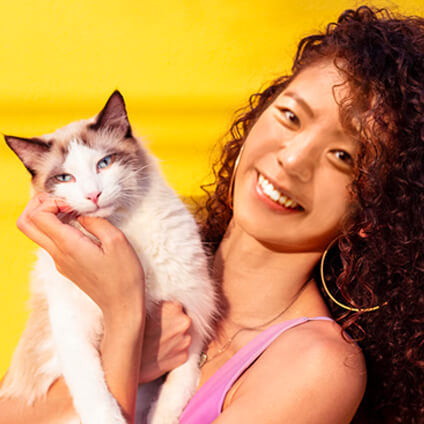
With over five years of specialized experience as an animal writer, my expertise lies in cat nutrition, health, behavior, grooming, and training. I am dedicated to delivering helpful and informative content that caters to the well-being of our feline friends. My primary goal is to empower pet owners with knowledge and ensure our feline companions thrive in health and happiness. In my free time, I love volunteering at local cat rescue centers.
